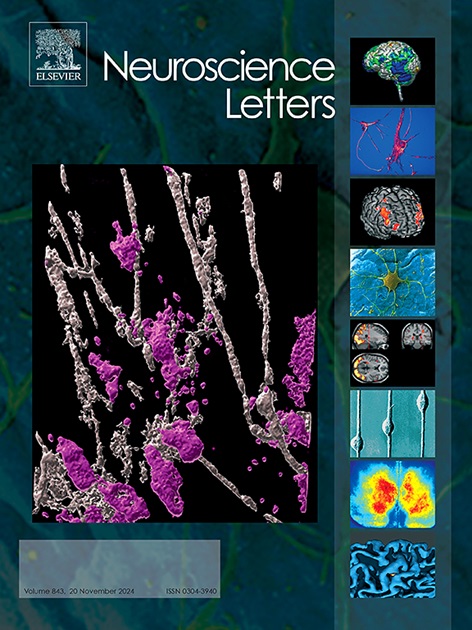Nischarin在发育大鼠脑中的时空表达通过PAK1/LIMK1/cofilin通路介导神经元迁移
IF 2.5
4区 医学
Q3 NEUROSCIENCES
引用次数: 0
摘要
Nischarin是一种细胞质支架蛋白,在调节细胞形态和功能中起着至关重要的作用。我们之前的研究显示它在成年大鼠大脑的某些区域高表达。然而,Nischarin在大鼠发育的不同阶段表达的复杂时空动态,以及它对神经系统功能的影响,仍未被探索。在这项研究中,我们仔细研究了Nischarin的表达模式和PAK1/LIMK1/cofilin信号级联的磷酸化谱,这些信号级联在大脑皮层和海马中从胚胎发育到出生后成熟。此外,我们还深入研究了Nischarin如何影响神经元迁移及其潜在机制。我们的研究结果表明,从出生后1天到28天,Nischarin在大脑皮层和海马中的蛋白和mRNA水平都有持续升高的趋势。有趣的是,PAK1和LIMK1的磷酸化水平在出生后第1天短暂升高,然后从出生后21天到28天逐渐下降。免疫共沉淀法显示内源性Nischarin与大脑皮层PAK1/LIMK1的相互作用。值得注意的是,抑制Nischarin的表达显著增强了神经2a细胞的迁移能力,同时提高了PAK1/LIMK1/cofilin信号通路的磷酸化水平。PAK1抑制剂IPA3有效地抵消了这种升高。我们的研究表明,Nischarin蛋白在发育过程中的逐渐增加可能是大鼠大脑正常发育轨迹的组成部分。这种参与似乎是由Nischarin通过调节PAK1/LIMK1/cofilin信号通路的活性来调节神经元迁移介导的。本文章由计算机程序翻译,如有差异,请以英文原文为准。

Spatiotemporal expression of Nischarin in developing rat brain mediates neuronal migration via the PAK1/LIMK1/cofilin pathway
Nischarin, a cytoplasmic scaffold protein, plays a crucial role in modulating cell morphology and function. Our prior investigations revealed its high expression in certain areas of the adult rat brain. Yet, the intricate spatiotemporal dynamics of Nischarin expression across various stages of rat development, as well as its influence on the nervous system’s functionality, remain unexplored. In this study, we meticulously examined the expression patterns of Nischarin and the phosphorylation profiles of the PAK1/LIMK1/cofilin signaling cascade within the cerebral cortex and hippocampus, spanning from embryonic development through postnatal maturation. Furthermore, we delved into how Nischarin affects the neuronal migration and the underlying mechanisms. Our findings indicated that from postnatal day 1 to 28, there was a consistent increasing trend in both the protein and mRNA levels of Nischarin in the cerebral cortex and hippocampus. Interestingly, the phosphorylation levels of PAK1 and LIMK1 increased briefly at postnatal day 1, and then gradually decreased from postnatal day 21 to 28. Immunocoprecipitation revealed the interaction between endogenous Nischarin and PAK1/LIMK1 in the cerebral cortex. Notably, suppressing Nischarin expression markedly bolstered the migration ability of Neuro-2a cells and concurrently elevated the phosphorylation levels of the PAK1/LIMK1/cofilin signaling pathway. This elevation was effectively counteracted by the PAK1 inhibitor IPA3. Our research suggests that the progressive increase in Nischarin protein expression during development is likely integral to the normal developmental trajectory of the rat brain. This involvement appears to be mediated by Nischarin’s regulation of neuronal migration through modulating the activity of the PAK1/LIMK1/cofilin signaling pathway.
求助全文
通过发布文献求助,成功后即可免费获取论文全文。
去求助
来源期刊

Neuroscience Letters
医学-神经科学
CiteScore
5.20
自引率
0.00%
发文量
408
审稿时长
50 days
期刊介绍:
Neuroscience Letters is devoted to the rapid publication of short, high-quality papers of interest to the broad community of neuroscientists. Only papers which will make a significant addition to the literature in the field will be published. Papers in all areas of neuroscience - molecular, cellular, developmental, systems, behavioral and cognitive, as well as computational - will be considered for publication. Submission of laboratory investigations that shed light on disease mechanisms is encouraged. Special Issues, edited by Guest Editors to cover new and rapidly-moving areas, will include invited mini-reviews. Occasional mini-reviews in especially timely areas will be considered for publication, without invitation, outside of Special Issues; these un-solicited mini-reviews can be submitted without invitation but must be of very high quality. Clinical studies will also be published if they provide new information about organization or actions of the nervous system, or provide new insights into the neurobiology of disease. NSL does not publish case reports.
 求助内容:
求助内容: 应助结果提醒方式:
应助结果提醒方式:


